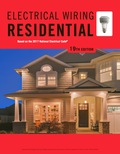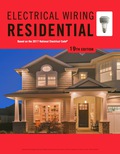
EBK ELECTRICAL WIRING RESIDENTIAL
19th Edition
ISBN: 9781337516549
Author: Simmons
Publisher: CENGAGE LEARNING - CONSIGNMENT
expand_more
expand_more
format_list_bulleted
Concept explainers
Question
Chapter 2.1, Problem 15R
To determine
Explain the indication of curved lines running between switches and various outlets in a plan.
Expert Solution & Answer
Trending nowThis is a popular solution!

Students have asked these similar questions
6. A JFET (IDSS
bias point?
=
10 mA,Vp=-5 V) is biased at ID
=
IDSS/4. What is the value of gm at that
Refer to Exhibit #15. On the kitchen pion for the northwest comer of room 132, what does the number 29, its associated electrical symbol, and the 46" AFF indicate?
Q1/For the unity-feedback system where G (s)
=
K(s+ 1)(s+ 10)
(s+4) (s-6)
Sketch the root locus and find the value of K for which the system is closed-loop stable.
Also find the break-in and breakaway points.
Chapter 2 Solutions
EBK ELECTRICAL WIRING RESIDENTIAL
Ch. 2.1 - What is the purpose of specifications?Ch. 2.1 - Refer to the specifications in the back of this...Ch. 2.1 - What is done to prevent a plan from becoming...Ch. 2.1 - Name three requirements contained in the...Ch. 2.1 - Prob. 5RCh. 2.1 - What phrase is used when a substitution is...Ch. 2.1 - What is the purpose of an electrical symbol?...Ch. 2.1 - Prob. 8RCh. 2.1 - Prob. 9RCh. 2.1 - What three parties must be satisfied with the...
Ch. 2.1 - What does a plan show about electrical outlets?...Ch. 2.1 - Prob. 13RCh. 2.1 - Prob. 14RCh. 2.1 - Prob. 15RCh. 2.1 - Prob. 16RCh. 2.1 - Prob. 17RCh. 2.1 - Prob. 18RCh. 2.1 - Prob. 19RCh. 2.1 - What methods may be used to mount luminaries to an...Ch. 2.1 - What advantage does a 4 in. octagon box have over...Ch. 2.1 - What is the size of the opening of a switch...Ch. 2.1 - Prob. 23RCh. 2.1 - Prob. 24RCh. 2.1 - Prob. 25RCh. 2.1 - Prob. 26RCh. 2.1 - Prob. 27RCh. 2.1 - Prob. 28RCh. 2.1 - Prob. 29RCh. 2.1 - Prob. 30RCh. 2.1 - Prob. 31RCh. 2.1 - Prob. 32RCh. 2.1 - Prob. 33RCh. 2.1 - Prob. 35RCh. 2.1 - Prob. 37RCh. 2.1 - Prob. 38RCh. 2.1 - Prob. 39RCh. 2.1 - Prob. 40RCh. 2.1 - Prob. 42RCh. 2.1 - Does the NEC allow metal raceways to be used with...Ch. 2.2 - Prob. 1RCh. 2.2 - What is the size of the footing for the steel...Ch. 2.2 - Prob. 3RCh. 2.2 - Prob. 4RCh. 2.2 - Prob. 5RCh. 2.2 - Prob. 6RCh. 2.2 - How far is the front garage wall from the curb?...Ch. 2.2 - How far is the side garage wall from the property...Ch. 2.2 - Prob. 9RCh. 2.2 - What is the purpose of the I-beams that rest on...Ch. 2.2 - Where is access to the attic provided?...Ch. 2.2 - Prob. 13RCh. 2.2 - Prob. 14RCh. 2.2 - Prob. 15RCh. 2.2 - Prob. 16RCh. 2.2 - What is the stud size for the partitions between...Ch. 2.2 - Who is to furnish the range hood?...Ch. 2.2 - Who is to install the range hood?...
Knowledge Booster
Learn more about
Need a deep-dive on the concept behind this application? Look no further. Learn more about this topic, electrical-engineering and related others by exploring similar questions and additional content below.Similar questions
- The switch K at Figure 4 is closed at t = 0.2 second. Assuming iL(0) = 0, Find iL(t). 10 Ω w i₁(t) 2ix 20 Ω 2H 10u(t) t = 0.2 s Figure 4 Karrow_forwardThe voltage source in the circuit of Fig. P12.31 is, givenby us(t) = [10+5u(t)] V. Determine iL(t) for t ≥ 0, given thatR1 = 1 W, R2 = 1 W, L = 2 H, and C = 1 F.arrow_forwardDon't use ai to answer I will report you answerarrow_forward
- Determine iL(t) in the circuit of Fig. P12.25, given thatbefore closing the switch uC(0−)=12 V. Also, the element valuesare R = 2 W, L = 1.5 H, and C = 0.5 F.arrow_forwardThe switch in Figure 5 is closed at t = 0 second. Find the voltage of the capacitor, vc, for t> 0. 8Ω t=0 ww + 0.15H + 24U(-t) 80- 2.5mF VC 2A 0.1H Figure 5arrow_forwardQ1/For the unity-feedback system where G (s) = K(s+ 1)(s+ 10) (s+4) (s-6) G Sketch the root locus and find the value of K for which the system is closed-loop stable. Also find the break-in and breakaway points.arrow_forward
- 12.22 Repeat Problem 12.21, but assume that the switch hadbeen open for a long time and then closed at t = 0. Set the dcsource at 12 mV and the element values at R0 = 5 W, R1 = 10 W,R2 = 20 W, L = 2 H, and C = 0.4 F. question 21(Determine iL(t) in the circuit of Fig. P12.21 for t ≥ 0,given that the switch was opened at t = 0 after it had been closedfor a long time, us = 12 mV, R0 = 5 W, R1 = 10 W, R2 = 20 W,L = 0.2 H, and C = 6 mF.)arrow_forwardIn Figure 1, by considering reference located at node 4, the voltage nodes will be: V1=4, V2= -5, V3=0.5 volts. If we change the location of reference to node 3, find the values for V1, V2, V4, ix, Vo, Vx and power produced by the current sources without conducting detailed node or mesh analyses. 10 www 4A ww 44 4Q 802 w + Vo 4Q 2 3 3ix Figure 1 ww 4Q 5 W4 1.50arrow_forwardIn the Figure 3 a) Find the values for Vi and ix using nodal analysis. b) Find the produced power by the current source. 50 10Ω www 37A 10Ω 20 5 ix V₁ 200 ix Figure 3 ww 100 + 4V1arrow_forward
- 2) By series and parallel combinations find the equivalent capacitance for this circuit. ||15€ Cequivalent -66 6f 6E 12Farrow_forwardQ2/For the unity-feedback system where G(s) = K/[s (s+3) (s+ 5)], find the range of gain, K, for stability, instability, and the value of gain for marginal stability. For marginal stability also. Use the Nyquist criterion.arrow_forward240 Q3/Q1/For the system G(s)= H(s)=1 (s+2)(s+4)(s+5) a. Draw the Bode log-magnitude and phase plots. b. Evaluate gain margin, phase margin, zero dB frequency, and 180° ¿B=2020arrow_forward
arrow_back_ios
SEE MORE QUESTIONS
arrow_forward_ios
Recommended textbooks for you
 EBK ELECTRICAL WIRING RESIDENTIALElectrical EngineeringISBN:9781337516549Author:SimmonsPublisher:CENGAGE LEARNING - CONSIGNMENT
EBK ELECTRICAL WIRING RESIDENTIALElectrical EngineeringISBN:9781337516549Author:SimmonsPublisher:CENGAGE LEARNING - CONSIGNMENT

EBK ELECTRICAL WIRING RESIDENTIAL
Electrical Engineering
ISBN:9781337516549
Author:Simmons
Publisher:CENGAGE LEARNING - CONSIGNMENT
Why HIGH VOLTAGE DC power Transmission; Author: ElectroBOOM;https://www.youtube.com/watch?v=DFQG9kuXSxg;License: Standard Youtube License